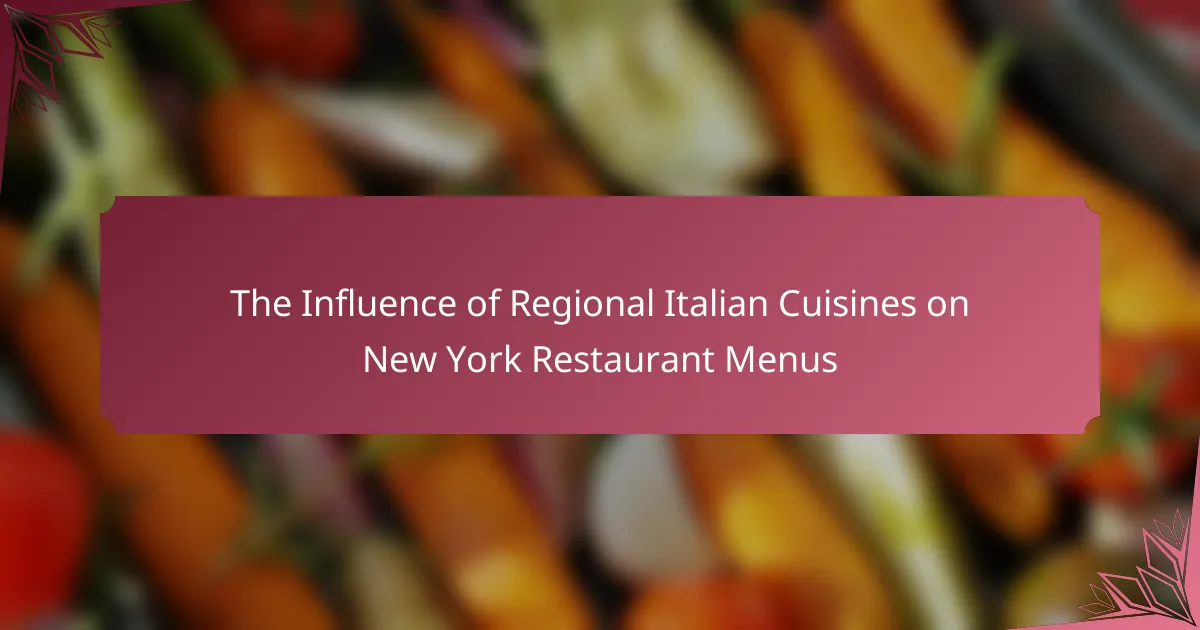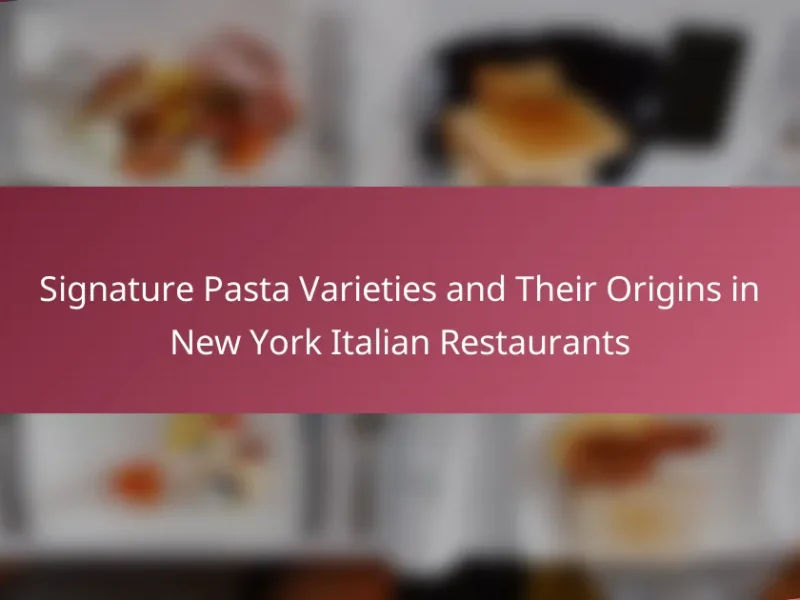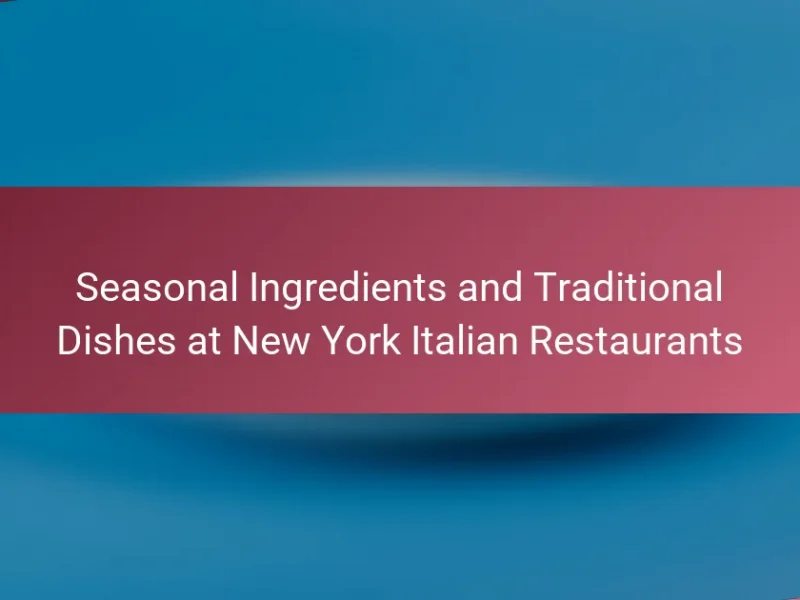Regional Italian cuisines play a significant role in shaping New York restaurant menus, with diverse dishes from regions like Naples, Sicily, Tuscany, and Emilia-Romagna becoming increasingly popular. Notable examples include Neapolitan pizza, Sicilian arancini, and Tuscan ribollita, all prepared using high-quality, often locally sourced ingredients. The influence of Italian-American communities and culinary events further enriches this landscape, encouraging chefs to innovate while maintaining authenticity. However, challenges such as sourcing authentic ingredients, consumer familiarity with regional dishes, menu pricing, and staff training impact the successful integration of these cuisines into New York’s vibrant dining scene. Overall, the article explores how regional Italian culinary traditions enhance the city’s gastronomic offerings, reflecting a blend of local preferences and authentic Italian heritage.

What is the Influence of Regional Italian Cuisines on New York Restaurant Menus?
Regional Italian cuisines significantly influence New York restaurant menus. This influence manifests through the incorporation of diverse regional dishes. For instance, Neapolitan pizza has gained popularity, emphasizing high-quality ingredients and traditional cooking methods. Sicilian dishes, like arancini and caponata, also feature prominently.
Restaurants often adapt recipes to local tastes while maintaining authenticity. New York chefs frequently travel to Italy for inspiration. This results in menus that reflect both local preferences and regional Italian traditions. The presence of Italian-American communities further enhances this culinary exchange.
Culinary events and festivals celebrate regional Italian flavors, increasing their visibility. Overall, regional Italian cuisines enrich New York’s culinary landscape, offering a variety of authentic dining experiences.
How do regional Italian cuisines differ from one another?
Regional Italian cuisines differ significantly due to variations in ingredients, cooking methods, and cultural influences. Northern Italian cuisine often features creamy sauces and ingredients like rice and polenta, reflecting its agricultural landscape. In contrast, Southern Italian cuisine emphasizes tomato-based dishes, olive oil, and seafood, influenced by Mediterranean traditions.
For example, the use of fresh herbs is prevalent in the cuisine of Liguria, while the cuisine of Sicily showcases bold spices and sweet flavors. Additionally, regional differences can be seen in pasta types; for instance, egg-based pasta is common in the north, while durum wheat pasta is favored in the south.
Historical trade routes and local agriculture have shaped these culinary distinctions. Regions like Emilia-Romagna are known for their rich cheeses and cured meats, while Campania is famous for its pizza and fresh produce. This diversity in regional cuisines contributes to a rich tapestry of flavors and dishes found in Italian restaurants worldwide, including those in New York.
What are the key characteristics of Northern Italian cuisine?
Northern Italian cuisine is characterized by its use of rich ingredients and diverse flavors. It often features butter and cream instead of olive oil. Rice and polenta are staple carbohydrates, frequently replacing pasta. The cuisine emphasizes fresh vegetables, herbs, and meats, particularly from local sources. Dishes often incorporate cheese varieties, such as Gorgonzola and Parmigiano-Reggiano. Northern Italy is known for its hearty risottos and flavorful stews. The region also showcases a variety of wine, particularly from vineyards like Barolo and Chianti. These elements reflect the agricultural and cultural influences unique to Northern Italy.
What defines Southern Italian cuisine?
Southern Italian cuisine is defined by its use of fresh, local ingredients and bold flavors. Common ingredients include tomatoes, olive oil, garlic, and various seafood. The cuisine emphasizes simplicity and rustic cooking techniques. Dishes often feature pasta, vegetables, and legumes. Southern Italy’s warm climate influences the use of sun-ripened produce. Traditional recipes are often passed down through generations. The region is known for its pizza, particularly Neapolitan-style. Historical influences from Greek, Arab, and Spanish cultures shape its unique flavors.
How do regional specialties shape Italian culinary traditions?
Regional specialties significantly shape Italian culinary traditions by reflecting local ingredients and cultural practices. Each region in Italy has unique dishes based on its geography and climate. For example, coastal areas emphasize seafood, while inland regions focus on meats and hearty vegetables. The use of specific herbs and spices also varies by region, enhancing distinct flavors. Traditional recipes are often passed down through generations, preserving regional identities. This diversity in cuisine contributes to Italy’s rich culinary heritage. Furthermore, regional specialties influence how Italian food is adapted and represented in places like New York. Many restaurants in New York showcase these regional dishes, providing authenticity to the dining experience.
Why is the influence of regional Italian cuisines significant in New York?
The influence of regional Italian cuisines is significant in New York because it enriches the city’s culinary diversity. New York is home to a large Italian-American population, which has preserved and adapted traditional recipes. This adaptation has led to the emergence of various Italian regional dishes in local restaurants. Dishes like Neapolitan pizza and Sicilian arancini are now staples in the city. Additionally, the use of authentic ingredients reflects the regional characteristics of Italian cooking. The culinary scene in New York showcases a blend of heritage and innovation. This fusion attracts both locals and tourists seeking authentic Italian flavors. The significance is evident in the numerous Italian restaurants that celebrate regional specialties across the city.
How has Italian immigration shaped New York’s culinary landscape?
Italian immigration has profoundly shaped New York’s culinary landscape. The influx of Italian immigrants in the late 19th and early 20th centuries introduced diverse regional cuisines. This led to the establishment of iconic dishes like pizza and pasta in the city. Italian neighborhoods, such as Little Italy, became centers for authentic Italian dining. Restaurants began to offer traditional recipes passed down through generations. The availability of Italian ingredients influenced local markets and grocery stores. By the mid-20th century, Italian cuisine became mainstream in New York. Today, Italian food remains a staple in New York’s diverse culinary scene.
What role do Italian communities play in preserving regional cuisines?
Italian communities play a crucial role in preserving regional cuisines. They maintain culinary traditions through family recipes and cooking practices. These communities often host cultural events that celebrate regional dishes. They also establish restaurants that feature authentic regional cuisine. By doing this, they keep traditional cooking methods alive. Many Italian Americans actively participate in local food festivals. These festivals showcase regional specialties and educate the public. Research indicates that such community efforts contribute to the ongoing popularity of regional Italian dishes.
What are the common regional dishes found in New York restaurants?
Common regional dishes found in New York restaurants include pizza, bagels, and deli sandwiches. New York-style pizza is characterized by its thin crust and large slices. Bagels, often topped with cream cheese, are a staple breakfast item. Deli sandwiches, particularly pastrami on rye, are iconic in the city. Additionally, Italian dishes such as pasta and risotto reflect the influence of Italian cuisine. These dishes are widely available in various restaurants throughout New York, showcasing the city’s diverse culinary landscape.
Which Northern Italian dishes are popular in New York dining establishments?
Popular Northern Italian dishes in New York dining establishments include risotto, polenta, and osso buco. Risotto is often made with Arborio rice and flavored with various ingredients like saffron or mushrooms. Polenta is a staple made from cornmeal, served creamy or grilled. Osso buco features braised veal shanks, typically served with gremolata. Additionally, dishes like caprese salad and tiramisu are frequently offered. These dishes reflect the rich culinary traditions of Northern Italy. Their popularity is evident in numerous Italian restaurants across New York City.
What Southern Italian dishes have gained traction in New York menus?
Southern Italian dishes that have gained traction in New York menus include pasta alla Norma, arancini, and sfincione. Pasta alla Norma features eggplant, tomatoes, and ricotta salata, showcasing Sicilian flavors. Arancini are stuffed rice balls, often filled with meat or cheese, popular as appetizers. Sfincione is a thick, Sicilian-style pizza topped with tomatoes, onions, and breadcrumbs. These dishes reflect the growing appreciation for authentic Southern Italian cuisine in New York. The rise of Southern Italian restaurants in the city has contributed to this trend, with many chefs focusing on regional specialties.

How do New York restaurants incorporate regional Italian cuisines?
New York restaurants incorporate regional Italian cuisines by offering diverse dishes that reflect Italy’s culinary landscape. They feature recipes from regions like Tuscany, Sicily, and Emilia-Romagna. For example, Tuscan restaurants may serve ribollita, a hearty vegetable soup. Sicilian establishments often highlight seafood dishes like spaghetti con le sarde.
Menus include regional ingredients, such as San Marzano tomatoes and Parmigiano-Reggiano cheese. Many chefs undergo training in Italy to master authentic techniques. Seasonal ingredients are utilized to create traditional dishes, aligning with Italian culinary practices.
The presence of Italian-American communities influences menu offerings, merging traditional recipes with local flavors. Popularity among diners drives restaurants to innovate while respecting regional authenticity. This approach ensures a rich representation of Italy’s diverse culinary heritage in New York’s dining scene.
What are the methods used by chefs to adapt regional Italian dishes?
Chefs adapt regional Italian dishes through ingredient substitution, reinterpretation of traditional recipes, and fusion with local flavors. Ingredient substitution involves using locally sourced produce instead of traditional Italian ingredients. This allows chefs to maintain freshness while catering to regional tastes. Reinterpretation of traditional recipes includes modifying cooking techniques or presentation styles to suit contemporary dining preferences. Fusion with local flavors incorporates elements from other cuisines, creating unique dishes that appeal to diverse palates. These methods reflect the evolving nature of Italian cuisine in response to cultural influences and customer preferences.
How do chefs balance authenticity and local preferences?
Chefs balance authenticity and local preferences by adapting traditional recipes to suit local tastes. They often incorporate local ingredients to enhance flavor and appeal. This approach maintains cultural integrity while ensuring customer satisfaction. Chefs study regional preferences to identify popular flavors and textures. They may also modify cooking techniques to align with local dining habits. For instance, a chef might serve a classic Italian dish with a New York twist. This method creates a fusion that respects both heritage and local culture. Research shows that this balancing act can increase a restaurant’s popularity and customer loyalty.
What ingredients are commonly sourced for these adaptations?
Commonly sourced ingredients for adaptations of regional Italian cuisines in New York include tomatoes, olive oil, garlic, and basil. These ingredients are foundational in many Italian dishes. Additionally, cheeses like mozzarella and Parmigiano-Reggiano are frequently used. Meats such as prosciutto and sausage are also popular choices. Fresh vegetables like zucchini and eggplant are often incorporated into recipes. These ingredients reflect traditional Italian cooking practices. Their availability in local markets supports their use in New York restaurants. This sourcing contributes to the authenticity of the regional adaptations.
How do seasonal changes affect the representation of regional cuisines?
Seasonal changes significantly affect the representation of regional cuisines. Ingredients vary in availability, impacting menu offerings. For instance, summer brings fresh vegetables and fruits, while winter favors root vegetables and hearty dishes. New York restaurants often adapt their menus to reflect these seasonal shifts. This practice enhances the authenticity of regional Italian cuisines. Seasonal dishes can highlight local produce, aligning with traditional culinary practices. Consumers increasingly seek seasonal menus, driving restaurants to showcase these changes. Research shows that 70% of diners prefer seasonal options, confirming this trend in dining preferences.
What seasonal ingredients influence menu changes?
Seasonal ingredients that influence menu changes include tomatoes, basil, and squash in summer. In fall, ingredients like pumpkin, apples, and mushrooms become prominent. Winter brings root vegetables such as carrots and parsnips. Spring introduces asparagus, peas, and artichokes. These ingredients reflect the availability of fresh produce throughout the year. Restaurants often adapt their menus to highlight these seasonal offerings. This practice enhances flavor and supports local agriculture. Seasonal menus also attract customers looking for fresh, vibrant dishes.
How do chefs highlight regional cuisines during specific seasons?
Chefs highlight regional cuisines during specific seasons by using seasonal ingredients native to those regions. They create dishes that reflect local traditions and flavors. For example, in spring, chefs may incorporate fresh vegetables like asparagus and peas. In summer, they might focus on tomatoes and basil, which are abundant in Italian regions. Autumn brings ingredients like squash and mushrooms into the spotlight. Winter often sees the use of hearty grains and preserved items. This approach not only showcases the essence of the region but also aligns with sustainability practices. Chefs aim to provide diners with an authentic taste of the season and region, enhancing the dining experience.

What challenges do New York restaurants face when featuring regional Italian cuisines?
New York restaurants face several challenges when featuring regional Italian cuisines. Sourcing authentic ingredients is a primary obstacle. Many regional dishes require specific components that may not be readily available in the U.S. This can lead to increased costs and difficulty in maintaining authenticity.
Additionally, there is a lack of consumer familiarity with certain regional dishes. Customers may prefer more mainstream Italian options, making it challenging for restaurants to introduce lesser-known cuisines.
Menu pricing is another issue. Authentic regional dishes often involve complex preparation methods, which can drive up labor costs. This can lead to higher menu prices, potentially deterring price-sensitive customers.
Furthermore, competition is fierce in New York’s restaurant scene. Many establishments offer Italian cuisine, making it difficult for those focusing on regional specialties to stand out.
Lastly, staff training is essential but challenging. Employees need to understand the nuances of regional cuisines to provide accurate recommendations and enhance the dining experience.
What are the sourcing challenges for authentic ingredients?
Sourcing challenges for authentic ingredients include availability, quality, and traceability. Many authentic Italian ingredients are region-specific and not widely produced. This limited availability can drive up costs and complicate procurement. Quality can vary significantly among suppliers, making it hard to ensure consistency in dishes. Traceability is crucial for authenticity but can be difficult to verify. Some suppliers may lack proper documentation or certification. Additionally, seasonal variations affect the supply of fresh ingredients. These challenges can hinder restaurants aiming to provide an authentic Italian dining experience.
How do supply chain issues affect menu offerings?
Supply chain issues significantly impact menu offerings by limiting ingredient availability. Restaurants may face shortages of key items, forcing them to alter their menus. For example, a lack of fresh produce can lead to the removal of seasonal dishes. Additionally, disruptions can increase ingredient costs, affecting pricing strategies. When specific Italian ingredients are unavailable, restaurants may substitute with alternatives, changing the dish’s authenticity. This can dilute the representation of regional Italian cuisines in New York menus. As a result, diners may experience less variety and authenticity in their dining options.
What are the cost implications of using authentic regional ingredients?
Using authentic regional ingredients can significantly increase costs for restaurants. These ingredients often have higher prices due to limited availability and sourcing challenges. For example, specific Italian cheeses or cured meats may need to be imported, incurring shipping and import fees. Additionally, seasonal availability can lead to fluctuating prices, impacting menu pricing strategies. A study by the Culinary Institute of America found that restaurants using local and authentic ingredients reported a 20% increase in food costs. However, these ingredients can also enhance menu appeal and justify higher prices, potentially increasing overall revenue.
How do diners respond to regional Italian cuisine offerings?
Diners generally respond positively to regional Italian cuisine offerings. They appreciate the authenticity and diversity of flavors. Regional dishes often evoke a sense of nostalgia and cultural connection. Many diners seek out specific regional specialties, such as Neapolitan pizza or Tuscan ribollita. This interest can lead to increased patronage of restaurants featuring these offerings. A survey by the National Restaurant Association indicated that 67% of diners enjoy trying regional cuisines. Additionally, diners often share their experiences on social media, further promoting these dishes. Overall, the response is marked by enthusiasm and a desire for culinary exploration.
What trends are emerging in customer preferences for Italian food?
Customers are increasingly favoring authentic regional Italian dishes. There is a growing interest in lesser-known regional cuisines, such as Sicilian and Pugliese. Diners seek fresh, locally-sourced ingredients in their meals. Plant-based Italian options are becoming more popular among health-conscious consumers. Traditional recipes are being reinterpreted to suit modern tastes. Consumers are also showing preference for artisanal pasta and sauces. The rise of food delivery services is influencing how customers experience Italian cuisine. These trends reflect a desire for both authenticity and innovation in Italian food offerings.
How do diners perceive authenticity in regional Italian dishes?
Diners perceive authenticity in regional Italian dishes through factors such as ingredient sourcing, traditional preparation methods, and cultural representation. Authenticity is often associated with the use of local and high-quality ingredients that reflect the specific region of Italy. Traditional cooking techniques, passed down through generations, enhance the perceived authenticity of the dish. Cultural representation, including the presentation and context of the meal, also plays a crucial role. Research indicates that diners often seek dishes that evoke a sense of place and heritage. A study by the Culinary Institute of America highlights that 70% of diners prioritize authenticity when choosing Italian cuisine.
What best practices can restaurants follow to successfully feature regional Italian cuisines?
Restaurants can successfully feature regional Italian cuisines by sourcing authentic ingredients. Utilizing local suppliers who specialize in Italian products ensures quality. Training staff on regional dishes enhances customer experience. Offering seasonal menus reflects the diversity of Italian regions. Creating partnerships with Italian chefs can bring authenticity to the kitchen. Engaging in community events promotes cultural appreciation. Providing educational materials about the dishes enriches diners’ understanding. These practices help restaurants stand out and attract customers interested in genuine Italian cuisine.
How can restaurants effectively market regional dishes to attract customers?
Restaurants can effectively market regional dishes by highlighting their unique cultural significance. They should use storytelling to connect the dish to its origin. Visual appeal is critical; high-quality images can attract attention. Social media platforms are ideal for sharing these visuals and engaging with customers. Collaborating with local influencers can expand reach and credibility. Offering tasting events allows customers to experience the dish firsthand. Additionally, using local ingredients can emphasize authenticity and support community farmers. According to a study by the National Restaurant Association, 60% of diners are more likely to choose a restaurant that features local cuisine.
What strategies can enhance the dining experience with regional Italian cuisines?
Incorporating regional Italian cuisines into dining experiences can be enhanced through authentic ingredient sourcing. Using locally sourced, high-quality ingredients reflects the true essence of Italian cooking. Offering traditional dishes from specific Italian regions adds authenticity to the menu. For example, featuring Naples’ pizza or Tuscany’s ribollita showcases regional diversity.
Engaging knowledgeable staff to explain dishes enriches the customer experience. Staff can share stories behind each dish, enhancing appreciation. Creating a themed ambiance that reflects Italian culture can further immerse diners. This may include decor, music, and table settings that evoke Italy’s charm.
Providing cooking classes or wine pairings can also enhance the experience. These activities educate diners about regional specialties and enhance their connection to the cuisine. Regularly updating the menu with seasonal regional specialties keeps the dining experience fresh and exciting. This strategy encourages repeat visits and customer loyalty.
The main entity of the article is regional Italian cuisines and their influence on New York restaurant menus. The article outlines how diverse regional dishes, such as Neapolitan pizza and Sicilian arancini, have become staples in New York due to the city’s Italian-American population and culinary events. It discusses the key differences between Northern and Southern Italian cuisines, the challenges faced by restaurants in sourcing authentic ingredients, and the methods chefs use to adapt these dishes for local preferences. Additionally, it highlights the importance of community efforts in preserving these culinary traditions and the positive response from diners seeking authentic Italian flavors.


